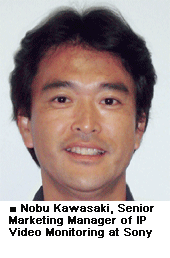Sony supports both single-vendor and multi-vendor systems equally. The advantage of a single-vendor system is stable connectivity; each device has been certified for connectivity in the system by the vendor. Also, any new features embedded on devices are fully supported by other devices in the system. For example, Sony's network surveillance softwareReal Shot Managerand its network surveillance recorders fully support the Distributed Enhanced Processing Architecture (DEPA) function embedded on Sony multi-codec network cameras. For dealers or system integrators that want simple integrated solution sets provided by one vendor, the single-vendor system is the best solution, with easy installation and end-user support. However, flexibility for system customization or upgrades is very limited.
Sony supports both single-vendor and multi-vendor systems equally. The advantage of a single-vendor system is stable connectivity; each device has been certified for connectivity in the system by the vendor. Also, any new features embedded on devices are fully supported by other devices in the system. For example, Sony's network surveillance softwareReal Shot Managerand its network surveillance recorders fully support the Distributed Enhanced Processing Architecture (DEPA) function embedded on Sony multi-codec network cameras. For dealers or system integrators that want simple integrated solution sets provided by one vendor, the single-vendor system is the best solution, with easy installation and end-user support. However, flexibility for system customization or upgrades is very limited.
The advantage of the multi-vendor system is flexibility of system integration.  Work flow, needs and requirements of end users differ. Dealers or system integrators can choose the best camera devices and applicationa server with software or network surveillance recordersfrom various vendors to meet end-user requirements. Sony provides a network camera software development kit (SDK) to third-party, independent software vendors (ISV) or independent hardware vendors (IHV) that are mostly vendors of security recorders to be certified.
Work flow, needs and requirements of end users differ. Dealers or system integrators can choose the best camera devices and applicationa server with software or network surveillance recordersfrom various vendors to meet end-user requirements. Sony provides a network camera software development kit (SDK) to third-party, independent software vendors (ISV) or independent hardware vendors (IHV) that are mostly vendors of security recorders to be certified.
New IP video surveillance technology has two potential markets. One is the traditional CCTV market, where end users are migrating to an IP-based system from the current analog-based one. Typically, the single-vendor system is controlled by a security facility management group with limited server and network knowledge. The other is the remote monitoring market, which requires video surveillance to cover wide areas. Instead of coaxial cabling, an IP network could meet the requirements of such environments. For required bandwidth, the end user can consider utilizing the existing network or adding a network dedicated to video surveillance.
Building a network on a wireless basis is another advantage of IP video surveillance. IT departments, which are in charge of computers and networking control, are involved in system consulting. With sufficient IT knowledge, the multi-vendor system may be preferred.